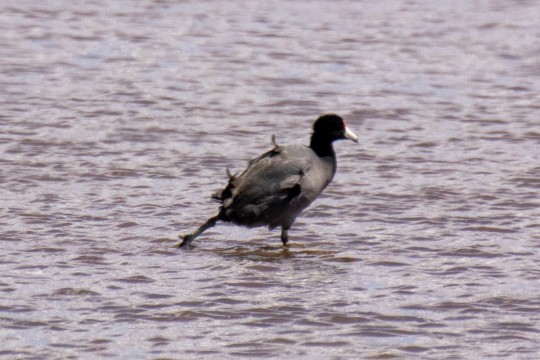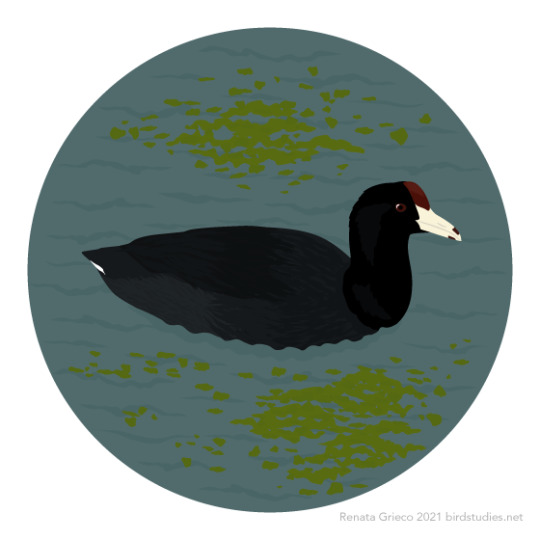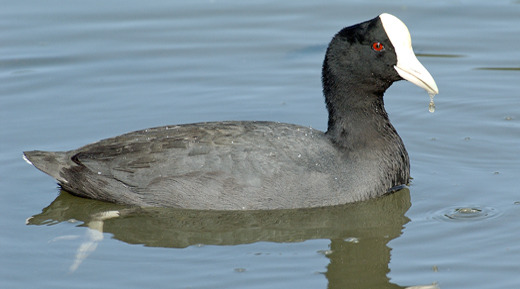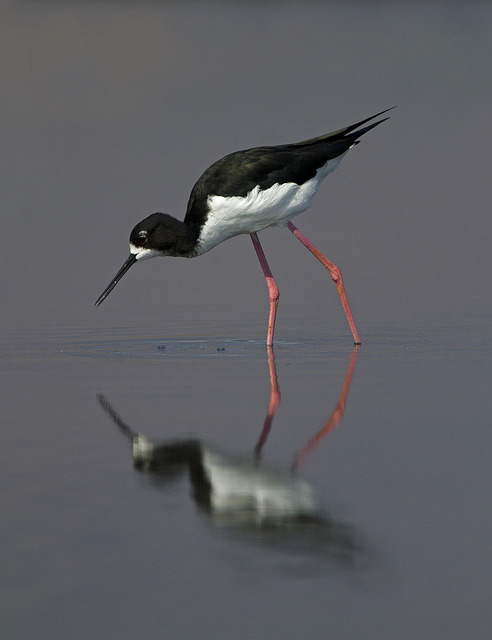#fulica alai
Photo

Hawaiian Coot (Fulica alai)
© Jack Lehman
30 notes
·
View notes
Photo

Hawaiian Coot (Fulica alai)
© Jack Lehman
17 notes
·
View notes
Photo

March 3, 2021 - Hawaiian Coot or ‘Alae ke‘oke‘o (Fulica alai)
Found only in Hawai‘i, these coots frequent taro fields, ponds, estuaries, marshes, and other wetlands. They eat seeds and leaves from aquatic plants, as well as grass, insects, crustaceans, snails, tadpoles, and small fish, foraging on land, from the water’s surface, or while diving. Breeding year round, but particularly between March and September, they build floating nests from aquatic vegetation in open water or attached to plants. Both parents incubate the clutches of three to ten eggs. They are classified as Vulnerable by the IUCN due to their small range and face threats from habitat degradation and loss, predation, and pollution.
49 notes
·
View notes
Photo

Fulica alai by SharifUddin59
39 notes
·
View notes
Text
Species Spotlight: Hawaiian Coot
Article by Elena Fischer, External Affairs Kupu AmeriCorps Intern with the U.S. Fish and Wildlife Service

An ‘alae ke’oke’o swims in water. Photo Credit: Dan Clark / USFWS
Scientific Name: Fulica alai
Hawaiian Name: ʻAlae keʻokeʻo / ‘Alae kea
Common Name: Hawaiian Coot
Status: Endangered
With a name that translates to white (kea) mudhen (‘alae), it is easy to imagine what these coots look like. However, the name may be misleading: it is not part of the hen family, but the rail family. Its geographic isolation on the main Hawaiian Islands has led to its uniqueness, separating itself from its mainland coot cousins. This isolation has also made it more precarious to extinction from habitat loss and predation. Since being on the Endangered Species List though, its croaking calls can be heard more frequently throughout the islands.

An ‘alae ke’oke’o swims in a reflective pool. Photo Credit: USFWS
Habitat and Range
ʻAlae keʻokeʻo are most common on the wetlands of O’ahu, Maui, and Kaua’i, but are found on all of the main Hawaiian islands except Kaho’olawe. These endangered native waterbirds prefer brackish and freshwater marshes and ponds. ʻAlae keʻokeʻo rarely fly, but they are able to sustain flight close to the water. They also are very territorial over nesting sites: they flap their wings to stay upright while kicking their feet, raise their tail feathers, and lower their head.
During breeding season (December to March) they prefer deeper water (18 inches deep) with emergent vegetation. The aquatic plants provide the vertical structure for nests and also provide cover for young birds.
Diet and Life Cycle
ʻAlae keʻokeʻo build floating nests on emergent vegetation in standing water, laying 3 to 10 eggs. Both parents help to raise the chicks, which hatch after 25 days. The young are precocial--they can run and swim soon after hatching--but still need care from the adults for several months. When born, chicks have black down except for their reddish-orange neck and head down. After fledging, both males and females will develop black feathers for the head, a slate gray body
with white undertail feathers, and a white frontal shield and bill.
‘Alae ke’oke’o are generalist feeders, often foraging in open water. They eat seeds and leaves of aquatic plants, insects, small invertebrates (snails and crustaceans), tadpoles, and small fish.

An adult ‘alae ke’oke’o holds food in its bill for two chicks, all swimming in water. Photo Credit: USFWS
Threats to the Species
Habitat loss remains a threat to the ‘alae ke’oke’o, as wetlands are being filled, dredged, contaminated by oil spills, or altered for agricultural and other reasons (see the ‘alae ‘ula blog for more threats). Introduced predators also pose a problem for habitat maintenance and predate upon ‘alae ke’oke’o. These include: feral dogs and cats, mongooses, rats, Cattle Egrets, bullfrogs, Barn Owls, and ‘auku‘u (black-crowned night herons). Invasive plants species also reduce water levels and necessary habitats for ‘alae ke’oke’o, like water hyacinth, mangrove, and pickleweed. Avian diseases like botulism also pose a concern.
Reason for Hope
Since the ‘alae ke’oke’o was listed on the Endangered Species List in 1970, its population numbers have increased across the state, thanks to inter-agency and organization collaboration on research and protection. These conservation actions include restoring wetland habitats, banning hunting, monitoring, and predator control.

An adult ‘alae ke’oke’o swims in open water. Photo Credit: USFWS
Where You Can See Them
Kakahai’a NWR
Keālia Pond NWR
James Campbell NWR
Pearl Harbor NWR
Hanalei NWR
Hulēʻia NWR
#conservation#wildlife#birds#waterbirds#birding#ornithology#refuges#usfws#nature#wetland#coots#hawaiincoot#hawaii#pacificislands#endangered#biology#savingspecies
37 notes
·
View notes
Photo

This funny little Coot (Fulica alai) found in our copy of Ornithology Mammology shows our disproportionate feathered friend in a stunning hand colored plate by Titian Ramsay Peale.
Peale, Titian Ramsay, 1799-1885. Ornithology. Mammalogy. [Philadelphia, Pa. : s.n., 1858?]
#bigfoot#feathursday#ornithology#1840s#LCPrarebooks#birdinhand#forthebirds#BensLibrary#SpecialCollections#Tumblarians
98 notes
·
View notes
Text
Recovering Endangered Species at Keālia Pond National Wildlife Refuge

Photo: Kealia Pond Nationa wildlife Refuge - The 700 acres of wetlands provides suitable nesting, feeding, and resting habitat for endangered waterbirds. Photo credit: USFWS
The U.S. Fish and Wildlife Service, through its Cooperative Recovery Initiative, is committing $3.74 million to nine projects on 12 national wildlife refuge across 12 states for recovery of some of the nation’s most at-risk species on or near national wildlife refuges.
“We are targeting our work where it will do the most good for America’s resources,” said Fish and Wildlife Service Acting Director Jim Kurth. “This initiative is a unique way to engage in conservation work with states and partners, giving the taxpayer a good return on investment.”

Endangered Hawaiian coot, ‘alae ke‘oke‘o, at Keālia Pond Refuge. Photo credit: Dan Clark/USFWS
At Keālia Pond National Wildlife Refuge, the Service is investing in a two year project to protect Hawaiian waterbirds and their core wetland habitats. The approximately 700 acres of wetlands protected by the refuge are essential habitat for native Hawaiian species, especially for the endangered Hawaiian coot, ‘alae ke‘oke‘o, (Fulica alai) and endangered Hawaiian stilt, ae‘o, (Himantopus mexicanus knudseni).
“Actions to benefit recovery of endangered birds, including the ‘alae ke‘oke‘o and ae‘o are a priority,” said Kristi Young, Deputy Field Supervisor for the Pacific Islands Fish and Wildlife Office. “National Wildlife Refuges play a critical role in the recovery of these species – providing safe places for the species and quality habitat.”

Photo: An Ae’o wading in the waters of Keālia Pond Refuge. Photo credit: Daniel Clark/USFWS
As the management tools and conservation measures significantly improve habitats for endangered species, the greater the possibility of species survival and recovery. The service closely monitors the effects of conservation actions and the impacts leading to the recovery of endangered species.
Invasive species like cats, rats, and pigs and habitat loss have hindered the recovery progress of these species. The project team will establish long-lasting protections against predators and ungulates, and create new habitat, resulting in a large-scale restoration of the refuge, a critically important wetland habitat in Hawaii. These efforts will also reduce predator pressure and enhance habitat at the refuge to further benefit waterbird species. Additional native species that will benefit from the project are endangered Hawaiian goose or nēnē and endangered Hawaiian duck or koloa.
“This project includes a new predator-proof fence around 400 acres of the Refuge, in addition to the habitat restoration that will take place,” said Oahu National Wildlife Refuge Complex Project Leader Joe Schwagerl. “Improving habitat quality and protecting native birds from invasive predators will increase nesting success for the threatened ‘alae ke‘oke‘o and endangered ae‘o, in addition to benefiting the many other native and migratory species that depend on the refuge.”

Photo: This predator proof fence is protects native Hawaiian species at Kilauea Point National Wildlife Refuge. Photo credit: Ann Bell/USFWS
Established in 1992, Keālia Pond National Wildlife Refuge encompasses approximately 700 acres and is one of the few natural wetlands remaining in the Hawaiian Islands. Located along the south-central coast of the island of Maui, between the towns of Kīhei and Mā‘alaea, it is a natural basin for a 56-square mile watershed from the West Maui Mountains.

Keālia Coastal Boardwalk. Photo credit: USFWS
The Keālia Coastal Boardwalk is a beautiful tranquil walkway and bird sanctuary, beside Maalaea Bay on the south edge of Maui's central valley. A walk on the boardwalk takes you through ancient wetlands where you can watch two of Hawaii's native and endangered waterbirds - the Hawaiian coot and Hawaiian stilt. Across the highway you can see Keālia Pond where waterfowl from Asia and North America come for rest and warmer climate, including northern shoveler and northern pintail. The Pacific golden plover migrates from Alaska, and other birds that come for the winter include the wandering tattler and ruddy turnstone.
The Cooperative Recovery Initiative was established in 2013 to restore and recover federally listed species on national wildlife refuges and surrounding lands. It funds on-the-ground conservation projects that provide high conservation benefits. These projects often provide related conservation benefits to other imperiled species and encourage partnerships with states and private groups.
To read more about the Pacific Region 2017 projects and previous years, visit https://www.fws.gov/refuges/whm/cri/.
10 notes
·
View notes